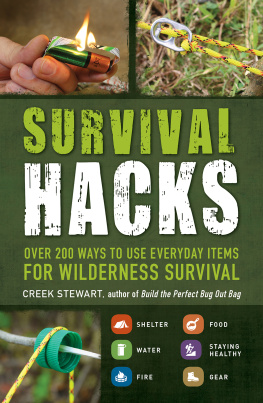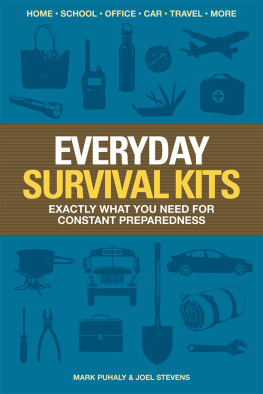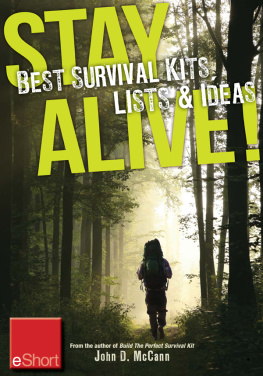
Text copyright 2015 Jim Cobb. Concept and design copyright 2015 Ulysses Press and its licensors. All rights reserved. Any unauthorized duplication in whole or in part or dissemination of this edition by any means (including but not limited to photocopying, electronic devices, digital versions, and the Internet) will be prosecuted to the fullest extent of the law.
Published in the US by:
Ulysses Press
P.O. Box 3440
Berkeley, CA 94703
www.ulyssespress.com
ISBN: 978-1-61243-519-0
Library of Congress Control Number: 2015937561
10 9 8 7 6 5 4 3 2 1
Acquisitions editor: Keith Riegert
Managing editor: Claire Chun
Editor: Renee Rutledge
Proofreader: Lauren Harrison
Design and layout: what!design @ whatweb.com
Cover artwork: from shutterstock.com; nuts and bolts Viktor Gladkov, screw heads set DeCe, cotton cable cord Szasz-Fabian Ilka Erika, utility knife Aleksandr Stepanov, hacksaw humbak, plastic bottles yalayama, newspapers xamnesiacx, batteries silabob
Index: Sayre Van Young
Distributed by Publishers Group West
PLEASE NOTE: This book is independently authored and published and no sponsorship or endorsement of this book by, and no affiliation with, any trademarked events, brands or other products mentioned or pictured within is claimed or suggested. All trademarks that appear in this book belong to their respective owners and are used here for informational purposes only. The author and publisher encourage readers to patronize the quality events, brands and other products mentioned and pictured in this book.
For Tammy. Every day, I fall for you just a little bit more.
CONTENTS
This book is very different from the others Ive written. Many readers of my previous books have asked for more photos. The thing is, in my other books, there really wasnt a whole lot that warranted illustration. I mean, sure, I could have included some sort of stock photo of a bunch of people standing around to accompany the topic of group versus individual survival planning. But, really, would that photo have added any true value to the book?
As an author, Ive always tried to be conscious of what Im providing to the reader in exchange for their hard-earned dollars. As a reader myself, Ive been suckered more than once by a flashy cover and some nifty graphics, only to find the text lacking. Too many writers look at photos and graphics as padding, rather than as actually adding value to the book. They look at photos, charts, diagrams, and all that fun stuff as a great way to add pages to the book, and thats about it. While a picture might indeed be worth a thousand words, it doesnt necessarily follow that a picture can fully replace all of those words. A great example of how photos are supposed to work can be found in any of my good friend John McCanns books, such as his excellent Practical Self-Reliance. He not only understands when a photo is needed, hes one hell of a photographer.
Leafing through the book youre holding (or scrolling through the pages on your tablet), youll no doubt notice there are a ton of photos. To be honest, this book was a pain in the butt to create because of all those pictures. Im not a photographer. I have a couple of friends who are, and they no doubt cringe and wince at any photos I post online or share with them. The composition is likely all messed up and the photo probably isnt framed the way it should be.
Heres the thing, though. The photos contained in this book arent meant to hang on the wall of your kitchen or den. I hold no illusions that anyone could look at a photo here and think it in any way approaches art. To my way of thinking, as long as the photos allow you to follow the bouncing ball and complete the projects, theyve served their purpose.
As for the projects themselves, theres some pretty neat stuff here. Some of it you may have seen before. I know the Milk Jug Lantern made the rounds online a while back. Why did I include it here? Two reasons, actually. First, there are going to be at least some readers of this book whove not seen it before. Second, part of the purpose of this book is to give you a resource to use during a disaster and the recovery period. Facebook and Google might not be viable options at that point. You might be in need of some sort of ambient lighting during an extended power outage and remember, Hey, one of Cobbs books had a few lanterns in it!
Other projects are likely to be brand-spankin new to you. Ive searched high and low for interesting ways to repurpose and recycle stuff you can find around the house and have put my own twists on a few ideas as well. Keep in mind, too, that the purpose of this book is doing, not just reading. Get up off your butt and actually try some of these projects. See what works for you and what doesnt. Few things in this book, if any, are truly universal. Every reader comes to the table with their own skill set, experience level, and individual circumstances.
Every project I chose to include in this book can be done by the average person. None require some sort of obscure tool or years of experience with carpentry, plumbing, or any other trade. In fact, just about any project in this book could be completed by a middle schooler. While some of the projects might be decidedly simplistic, they all work and will accomplish the intended goal. Thats the whole point, right?
Id love to hear from you and find out how youve fared with some of the projects in this book, as well as any youve come up with on your own. I answer all of my emails myself and maintain my own Facebook and Twitter accounts. If you send me a message, you can be assured it will reach me, not just some virtual assistant.
Email:
Facebook: Facebook.com/JimCobbSurvival
Twitter: Twitter.com/SurvivalWeekly
Web: SurvivalWeekly.com
One last thing. When youre working on these projects, please exercise common sense and good judgment. Make full use of the appropriate safety gear. Any time youre using tools, wear safety goggles. If youre cutting metal, whether with tin snips or a saw, make sure youre wearing gloves. While I want to hear about your successful projects, I really dont want you sending me pictures of lopped off fingers or the 72 stitches you needed after your failed attempt at making a Hobo Stove.
Have fun with this stuff, folks. Let your imagination run wild, get creative, and see what comes to mind after youve seen what others have done.
Common wisdom dictates that the human body can survive about three days without hydration. While that may be true in a technical sense, in the real world, the last day or two of that time period would be spent in agony and delirium. Dont ever try to ration water. If you have potable water available, drink it. The problem with rationing is that doing so may hinder your ability to search for more water sources. A far better plan is to keep your body running as efficiently as possible as you attempt to locate additional supplies.
It is almost as important to understand that water from natural sources, such as rivers, lakes, and ponds, absolutely must be treated before consumption. Failure to do so puts you at risk for some pretty serious health issues, such as giardia and cryptosporidium. The best way to treat water prior to drinking is to boil it. This will kill anything that might be in the water that could harm you. There is no need to let it boil for several minutes, either. Just bringing it to a rolling boil is sufficient.
Next page





